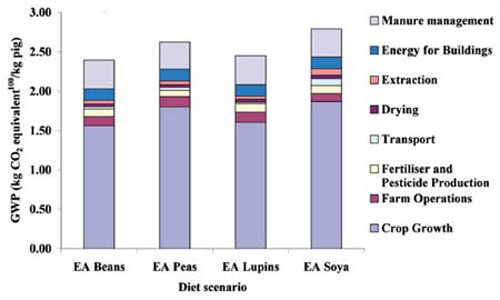



Life Cycle Assessment of UK Pig Production Systems
A Life Cycle Assessment (LCA) was developed to evaluate the environmental impacts of producing one kilo of pig liveweight, comparing diets based on home-grown peas, beans and lupins with imported soybean meal. The model, summarised in this 'Research into Action' No. 6 from BPEX, includes all processes involved in the production system but does not extend to transport of the pigs to slaughter or the slaughter process.Background and Method
The aim of the project was to quantify the environmental impacts of producing grower-finisher pigs (12–105kg) using different diet scenarios.
A Life Cycle Assessment (LCA) was developed to evaluate the environmental impacts of producing 1kg pig liveweight (LW). The model includes all processes involved in the production system but does not extend to transport of the pigs to slaughter or the slaughter process.
Diet Scenarios
- Conventional soybean-based diet
- Home-grown bean-based diet
- Home-grown pea-based diet
- Home-grown lupin-based diet.
The trial diet formulations were nutritionally equivalent.
Results
Two UK sites were modelled, one in East Anglia and the other in Yorkshire. A Brazilian corn-soya rotation was simulated for the production of soybean meal. Individual
soil and climate conditions were defined at each site and two fertiliser scenarios were modelled – synthetic and slurry – specifically to compare the effects of slurry management.
The environmental impacts assessed were:
- Global Warming Potential (GWP)
- Eutrophication
- Acidification

Results
- The bean-based diets resulted in the lowest GWP per kg pig LW ranging from1.85 to 2.67kg CO2 equivalent 100
- The soybean-based diets with the highest GWP per kg pig LW, 2.52 to 3.08kg CO2 equivalent 100
- Diet production contributed the most to per kg pig LW, i.e. 63.9 to 78.5 per cent. Transport contributed approximately one per cent to GWP in the home-grown diet scenarios, however in the soybean-based diet scenarios, this was on average three per cent.
- Eutrophication potentials were higher in the synthetic fertiliser scenario. The lupin-based diets were associated with the highest eutrophication potential at 0.056 to 0.133kg PO4 equivalent in both fertiliser scenarios. The pea-based diets were consistently associated with the lowest eutrophication potential, 0.049 to 0.103kg PO4 equivalent
- The soybean-based diets concluded with the highest acidification potential, 0.054 to 0.129kg SO2 equivalent in both fertiliser scenarios.
Conclusion
The results were weighted from the lowest to highest results for each environmental impact category for each diet scenario at each site.
The overall conclusion is that
the bean-based diets have the lowest environmental impacts per kg pig LW and the soybean-based diets have the highest environmental impacts per kg pig LW. Both the pea and lupin based diets have equal environmental impacts per kg pig LW.
This work highlighted that crop production is the main contributor to environmental impacts of pig production systems. It is also important to consider the fertiliser scenario when trying to reduce the environmental impacts within the management system. This has highlighted the importance for pig production systems to utilise slurry efficiently by considering crop nutrient
requirements and the relevance of minimising the amounts of applied synthetic fertiliser.

Further ReadingFor information on a related study, click here. |
March 2013








